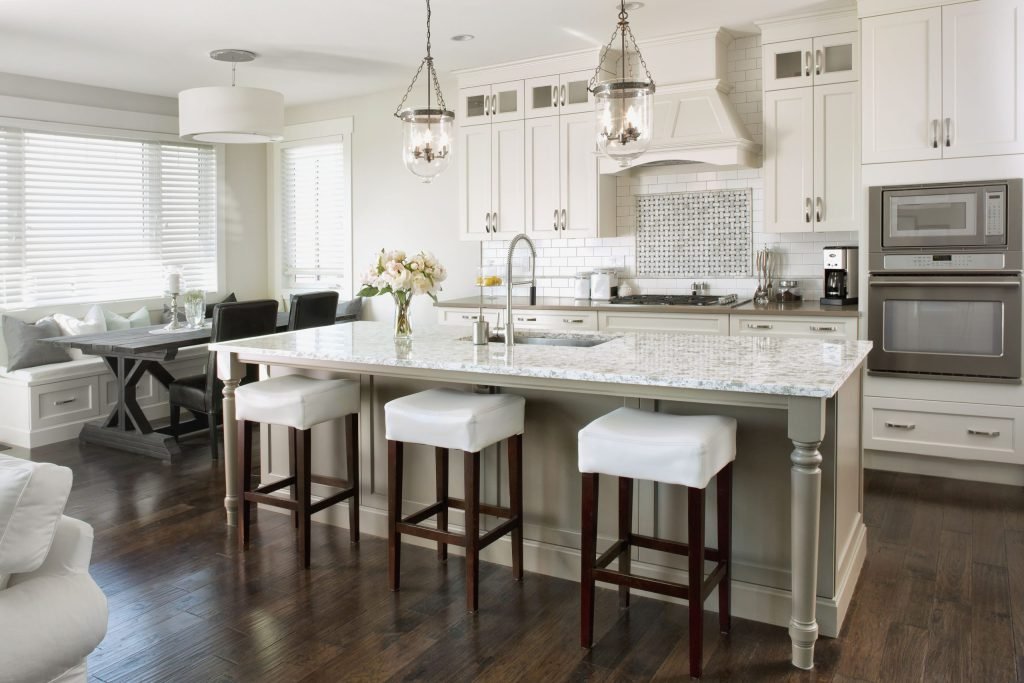Cabinet painting can transform your space, making it look refreshed and stylish. To ensure a successful cabinet painting project, follow these essential steps. First, prepare your cabinets properly. Clean them thoroughly to remove any grease or grime, and sand the surfaces to create a smooth base for the paint.
Choose high-quality paint explicitly designed for cabinets, offering durability and a professional finish. Use a primer to help the paint adhere better and prevent any stains from bleeding. When painting, apply multiple thin coats rather than one thick coat to avoid drips and ensure an even finish. Finally, adequate drying time between coats and after the final coat is allowed to ensure the best results. These cabinet painting steps are critical to a successful and long-lasting transformation.
Preparation and Cleaning
Proper preparation and cleaning are essential steps in cabinet painting. They ensure a smooth, long-lasting finish and set the foundation for a professional result.
- Remove Hardware: Start by taking off all cabinet hardware, including handles, knobs, and hinges. This step prevents paint from covering or damaging these components and allows you to paint every surface evenly.
- Clean Surfaces: Clean the cabinet surfaces with a degreaser or mild soap and water. This removes grease, dirt, and grime that can interfere with paint adhesion and lead to an uneven finish.
- Sand the Cabinets: Sanding the cabinet surfaces smooths out imperfections and provides a rough texture for better paint adhesion. Use fine-grit sandpaper and ensure you cover all areas evenly.
- Remove Dust: After sanding, remove all dust and debris using a tack cloth or a vacuum. Any residual dust can cause bumps and unevenness in the paint, so ensure surfaces are clean.
- Protect Surroundings: Cover surrounding areas with drop cloths or plastic sheeting to protect floors and countertops from paint splatters. Proper protection helps keep your workspace clean and prevents accidental damage.
Choosing the Right Paint
Selecting the right paint is fundamental for a successful cabinet painting project. Start by deciding on the type of paint that suits your needs, such as latex or oil-based options. Latex paint is famous for its easy cleanup and quick drying time, while oil-based paint offers a durable finish that can withstand heavy use. Next, choose a finish that complements your kitchen’s style, whether matte, satin, semi-gloss, or gloss.
Each finish offers benefits, such as easy cleaning or a high-shine look. High-quality paint is essential for durability and a smooth finish, so invest in reputable brands that provide good coverage and long-lasting results. Proper paint selection impacts your cabinets’ look and longevity, ensuring they remain attractive and functional over time.
Applying Primer
Applying primer is an essential part of preparing cabinets for painting. Primer improves paint adhesion and ensures a consistent surface for the topcoat. Begin by selecting a primer that complements the type of paint you’ll use—oil-based primers are ideal for oil-based paints, while latex primers are best for latex paints. Apply an even coat of primer to all cabinet surfaces, including edges and recessed areas.
Use a high-quality brush or roller to achieve a smooth and even application for the best results. This step helps cover any stains or old colors and creates a uniform base, allowing the topcoat to look even and adhere properly. Proper primer application is fundamental to achieving a professional-looking finish and prolonging the durability of your cabinet paint job.
Painting Techniques
The proper painting techniques are essential for achieving a smooth and professional finish on your cabinets. Select appropriate tools, such as high-quality brushes, rollers, or sprayers. Each tool offers different benefits: brushes are ideal for detailed areas, rollers work well for larger flat surfaces, and sprayers can provide a smooth finish over large areas. Apply paint in thin, even coats to avoid drips and achieve consistent coverage.
Start with a light hand and gradually build up the paint, allowing each coat to dry thoroughly before applying the next one. This method prevents runs and streaks, resulting in a flawless finish. Avoid overloading your brush or roller with paint, leading to uneven application. By following these techniques, you ensure a high-quality finish that enhances the overall appearance of your cabinets.
Drying and Curing
Drying and curing are critical phases in the cabinet painting process that affect the durability and appearance of the final coat. After applying paint, allow each coat to dry completely according to the manufacturer’s instructions. This typically involves waiting several hours between coats. Proper drying is necessary to prevent smudges, dents, or imperfections. Curing, however, takes longer and involves letting the paint harden fully, which can take up to a few weeks.
Avoid using or touching the cabinets to ensure the paint sets appropriately during this time. Humidity, temperature, and ventilation can impact drying and curing times, so be mindful of your environment. Allowing ample time for both drying and curing ensures that the paint job is durable and long-lasting, providing a beautiful finish that stands up to daily use.
Reassembling Cabinets
Once your cabinets are fully painted and cured, reassembling them correctly is essential to completing the project. Start by carefully reattaching the cabinet doors and any hardware you removed earlier. Check the doors’ alignment to ensure they open and close smoothly. If you notice any misalignment, adjust the hinges to correct it.
Reinstall handles, knobs, or pulls, ensuring they are securely fastened and properly aligned with the drilled holes. If you paint the cabinet interiors, ensure they are dry before placing items back inside. Finally, inspect the finished cabinets for any touch-ups needed. Proper reassembly and final adjustments will ensure that your cabinets look great and function perfectly in your space.
Maintenance Tips
Proper maintenance is key to keeping your cabinet painting project fresh and polished. Regular care ensures that your cabinets remain beautiful and functional over time.
- Regular Cleaning: Wipe down your cabinets weekly with a soft, damp cloth. Avoid harsh chemicals that could damage the paint. This keeps your cabinets free from dust and grime.
- Avoid Scratches: Handle cabinet doors and drawers gently to prevent scratches and dents. For minor blemishes, use touch-up paint to maintain a smooth finish.
- Address Spills Immediately: Clean up spills and stains as soon as they occur. This prevents them from setting and causing long-term damage to the painted surface.
- Inspect for Wear: Periodically check for signs of wear or peeling. Address any issues promptly by sanding and repainting affected areas to prevent further deterioration.
- Use Cabinet Liners: Liner your cabinets’ interior surfaces to prevent damage from items stored inside and make cleaning easier.
Choosing the Right Finish
Selecting the appropriate finish for your cabinet painting project can greatly influence the final look and functionality. Finishes range from matte, which offers a soft, non-reflective look, to semi-gloss and gloss, which provide a shiny, reflective surface that is easier to clean. Matte finishes can hide imperfections but may be more prone to stains, while semi-gloss and gloss finishes are more durable and resistant to moisture, making them ideal for high-traffic areas like kitchens.
When choosing a finish, consider the overall style of your space and the practical needs of your cabinets. For example, a high-gloss finish may complement a modern kitchen, while a matte finish might suit a more traditional style. Choosing the right finish ensures that the cabinets look good and perform well over time.
Handling Common Issues
Addressing common issues during the cabinet painting is essential for achieving a high-quality finish. Some frequent problems include streaks, drips, and uneven coverage. To handle streaks and drips, gently sand the affected area once dry and apply additional coats of paint carefully. Uneven coverage can often be fixed by applying a thin, even layer of paint and ensuring that each coat is fully dry before adding another.
If paint adhesion is an issue, it may be due to insufficient surface preparation or inappropriate paint. In such cases, properly clean and sand the cabinets before repainting, and ensure you use the correct primer and paint. Promptly addressing these issues can correct flaws and achieve a smooth, professional finish.
Preparing for Cabinet Painting
Effective preparation is key to a successful cabinet painting project. Start by organizing your workspace to ensure easy access to all tools and materials. Protect surrounding areas by covering floors, countertops, and adjacent surfaces with drop cloths or plastic sheeting. Remove any items from the cabinets, including shelves and drawer contents, to prevent damage and facilitate easier access.
Gather all necessary supplies, including paint, primer, brushes, rollers, and painter’s tape. Properly prepare the cabinet surfaces by cleaning, sanding, and priming as needed. Preparing your workspace and materials carefully sets the stage for a smooth painting process and helps avoid potential issues. This organized approach ensures that you can focus on achieving a beautiful finish without unnecessary interruptions or complications.
Successful cabinet painting requires attention to detail and careful execution of each step, from preparation to reassembly. You ensure a durable and attractive result by following the essential steps outlined—such as proper cleaning, choosing the right paint, applying primer, and selecting the appropriate finish. Regular maintenance will keep your cabinets looking fresh and beautiful for years. With these practices, you can achieve a professional finish that enhances your kitchen’s overall appearance and functionality.
Ready to transform your cabinets with a professional touch? Contact Full Coverage Painting today! Our experts are here to guide you through every step of the cabinet painting process. Visit us at 600 Buckeye St., Vacaville, CA 95688, or call us at 707-384-5108 to schedule your consultation. Let us help you achieve a stunning, long-lasting finish for your cabinets.







